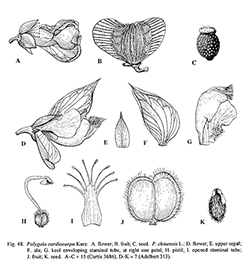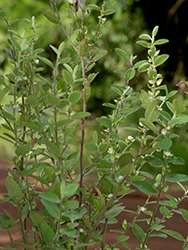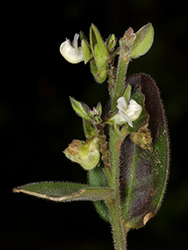e-Flora of Thailand
Volume 7 > Part 3 > Year 2001 > Page 503 > Polygalaceae > Polygala
3. Polygala chinensis L.wfo-0001240219
Sp. Pl.: 704. 1753; Meijden in Fl. Mal. 1, 10: 478. 1988. Fig. 48: D–K.
Accepted Name : This is currently accepted.
Synonyms & Citations :
Description : Erect sometimes woody herb 15–60 cm. Stems terete, indumentum of short curved and long patent hairs, especially on young parts. Leaves alternate to subopposite, elliptic to narrowly ovate or obovate, apex mucronate, acute to rounded or occasionally retuse, base cuneate to rounded or scarcely cordate, midrib flat or prominent above, margin inrolled, glabrous or ciliate, lamina sparsely to rather densely appressed hairy, glaucous below, 0.9–7.0 by 0.6–2.4 cm, length:width ratio 2–12; petiole with short curved hairs, 1.0-2.0 mm. Inflorescence supra-axillary, with 3–20 flowers, dense, unbranched, glabrescent or with short curved or long patent hairs, 0.5–3.0 cm; bracts very early caducous, broadly ovate or triangular, ciliate, 0.5–0.7 mm. Flowers greenish, white or pink, 3.5–4.5 mm; pedicel 0.5–1.5 mm. Outer sepals unequal, ovate, acuminate, ciliate, the two lower 1.4–2.1 mm, the upper 1.9–2.8 mm. Alae ovate or oblong, oblique, apex acuminate, margin ciliate, shortly hairy, or rarely with long, straight hairs, 4.2–7.0 by 1.1–2.3 mm. Upper petals spathulate or obtriangular, hairy in lower half, 3.2–5.0 mm, free parts 2.7–4.0 mm. Keel more or less auriculate, 4.7–5.5 mm, appendage of two more or less connate brush-like bundles, 2.0–2.5 mm. Stamens irregularly connate to about half-way, 4.4–6.0 mm. Disk absent. Ovary orbicular, densely long ciliate along margin towards apex, 0.7–1.0 by 0.8–1.0 mm; style curved, strongly reflexed apically, 3.5–5.5 mm. Capsule with persistent calyx, wider than long, orbicular or rectangular, emarginate, ciliate, sparsely short hairy and rarely with long straight hairs, 3.2–4.4 by 3.7–4.7 mm. Seeds ovoid to almost globular, black with short, white hairs, 2.1–3.3 by 1.4–2.1 mm; aril irregularly 3-lobed, the lobes 0.5–1.7 mm long.
Thailand : NORTHERN: Chiang Mai, Chiang Rai, Lamphun, Lampang, Phitsanulok, Nakhon Sawan; NORTH-EASTERN: Phetchabun, Loei, Khon Kaen; EASTERN: Chaiyaphum, Nakhon Ratchasima, Surin, Si Sa Ket, Ubon Ratchathani; SOUTH-WESTERN: Kanchanaburi, Ratchaburi, Phetchaburi; CENTRAL: Saraburi, Nakhon Nayok; SOUTH-EASTERN: Chanthaburi, Trat; PENINSULAR: Satun.
Distribution : Northeast India (type) to S China, Cambodia, Laos, Vietnam, Sumatra, Malay Peninsula, Java, Borneo, the Philippines, Lesser Sunda Islands, New Guinea.
Ecology : Grasslands or under dry deciduous, pine or evergreen forests, 0–2,000 m alt.
Vernacular : Pik kai dam (ปีกไก่ดำ); kham tia (คำเตี้ย)(Loei).
Uses: A decoction of the plant is used to treat kidney ailments by the Black Lahu, a hill tribe of northern Thailand.
Notes: The commonest species of Polygala in Thailand and one of the more variable. Polygala chinensis and P. polifolia are distinguished from the other herbaceous species by the short, dense inflorescence rachis which persists after the fruits have fallen. Polygala polifolia is smaller than P. chinensis, has pale blue rather than greenish-white flowers and has a very different staminal sheath.
The synonymy of Polygala chinensis, P. polifolia, P. glaucoides and P. triflora is complicated, and not completely clear. Meijden (l.c.) should be referred to for a more comprehensive treatment of these species.



